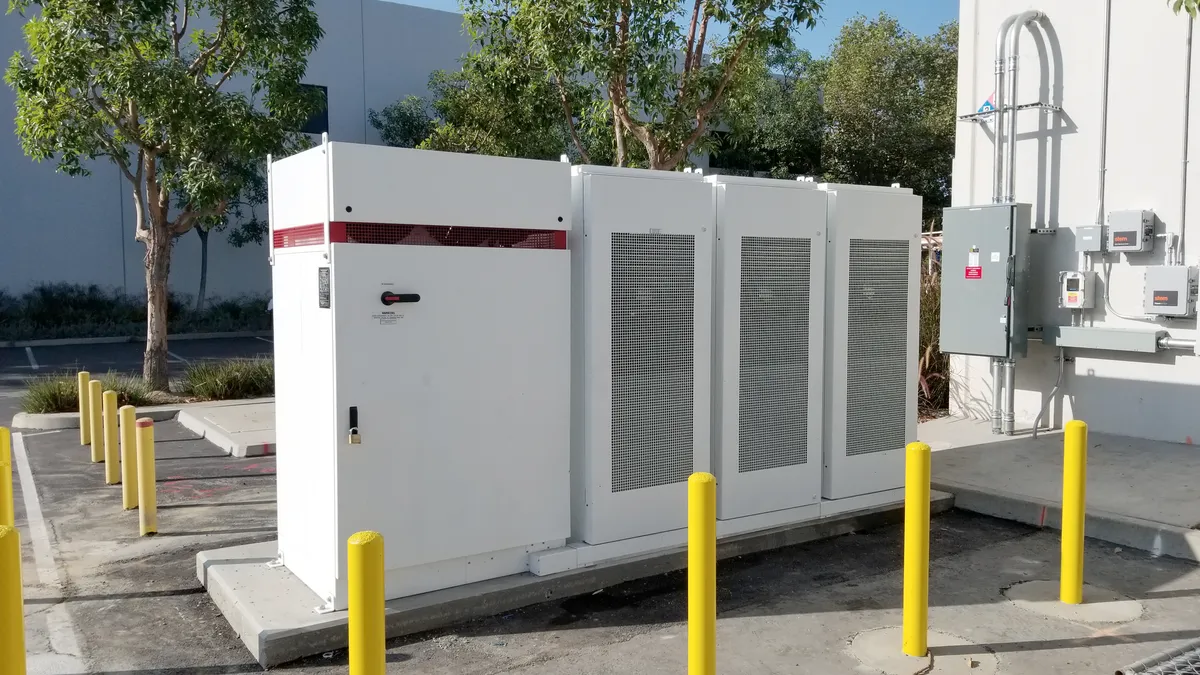Dive Brief:
- The competitive market responded to New York's 2030 storage goal by adding more than 12 GW of energy storage projects into the interconnection queue, according to the state's Department of Public Service.
- However, DPS and another analyst expect only a portion of those projects will come to fruition for the 6 GW goal. Projects are under development for the interim 1.5 GW goal in 2025, and the agency reported the state is close to meeting that target.
- The initial storage target, set in December 2018, was for 3 GW, before being doubled in January by Gov. Kathy Hochul as prices for imported lithium and other key battery metals rose higher.
Dive Insight:
Crimped supply chains, rising demand for batteries and higher costs of lithium used in ubiquitous lithium-ion batteries make for a steep climb ahead, experts say. But those negatives may turn out to be a positive.
The state will meet its storage goals through large front-of-meter battery projects, including ones likely fed by offshore wind coming online, and smaller distributed resources, according to DPS and PA Consulting.
The cost of installing retail, non-residential projects that recently won awards was an average $567 per kWh, according to an April 1 storage report by DPS. In 2020-21, the average installation costs of such projects was $464 per kWh. Regulators expect that the state's higher storage target and DPS and grid operator support will slash costs to $150-$200 kWh by the end of the decade, based on BloombergNEF estimates.
Few doubt that there are big challenges ahead on the storage front but both the state push and its need for unprecedented levels of grid storage may propel new technologies and drive down the costs.
"Long duration storage providers will make the case that their solutions can better compete and take on a large portion of the 6 GW pie, particularly as deeper decarbonization through intermittent offshore wind pushes storage requirements beyond the four-hour duration where lithium-ion thrives," Dan Finn-Foley, PA Consulting energy storage specialist, wrote in an email to Utility Dive.
Kevin Lanahan, New York Independent System Operator spokesperson, pointed to the market's response to the state's new target, and pending rules aimed at lowering market barriers for grid-connected batteries.
The vast majority of the 12,267 MW of storage projects seeking interconnection are front-of-the-meter. Projects that would connect to the bulk power system amount to 10,502 MW, but the figure rises to 11,135 MW when adding in projects to be built next to solar and wind projects, according to NYISO. The projects in the transmission and distribution queues are 50% more than lined up a year ago, DPS reported. The technologies were not revealed.
"The markets are driving investment because of technological advances, spurred in part by state and federal policy and ISO's market design changes easing entry for battery and storage resources," Lanahan said during a phone interview. In January, NYISO asked the Federal Energy Regulatory Commission to approve its proposal to lower hurdles for battery, wind and solar developments.
How many of the more than 12,000 MW of proposals get interconnected is unknown, but likely a fraction of them because of system requirements and/or financial reasons and other factors outside the state's control, according to DPS.
Finn-Foley estimates 10-15% of the proposed storage projects seeking interconnection will be commissioned unless there is "significant policy support."
Still, meeting the tight eight-year time frame for doubling storage to 6,000 MW will not be easy.
It "will require dramatic investment and buy-in across the board," Finn-Foley said, pointing to the rising demand on limited battery manufacturing capacity from other grids and the electric vehicle market's surging demand for lithium-ion batteries.
Maine, for example, which has 8% of New York's electric demand, established in 2021 the goal to install 400 MW of storage, with 300 MW to come online by 2025. Maine also faces short-term supply chain issues but it's "potentially magnified as it plans to front-load the majority of the 400 MW," Finn-Foley said.
DPS's report states there are 1,230 MW of battery storage expected to come online in New York, close to the 2018 target of 1,500 MW by 2025 set back in 2018. According to the NYISO, only 40 to 60 MW are online with the rest under development.
"Energy storage use cases continue to include pairing with the existing pipeline of distributed solar PV being developed in the State as well as large scale bulk-level connected projects," according to DPS's report. A driver of the PV-battery projects is their eligibility for payments for grid services under the Value of Distributed Energy Resource Compensation.
In addition, New York's 9,000 MW of offshore wind developments, with more than 3,000 MW expected to come online around 2027, could feed big batteries to support the grid when the wind drops, according to PA Consulting. An ideal location for a large amount of this storage is Long Island but a challenge is that it is a densely populated suburban region.
If that or other factors thwart batteries from being co-located with renewables, stand-alone storage could worsen the stress on the grid by driving up load, experts say.














